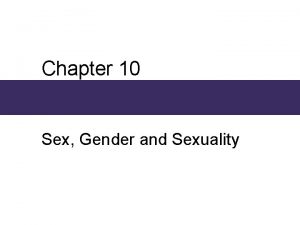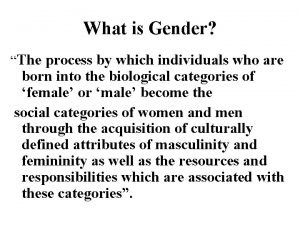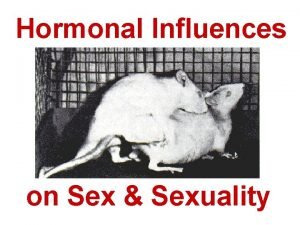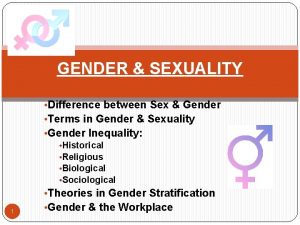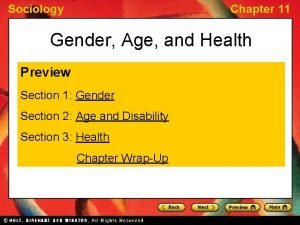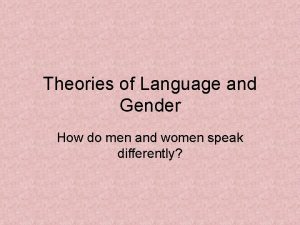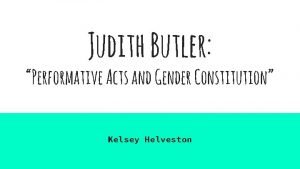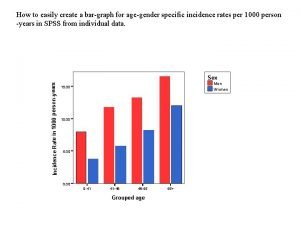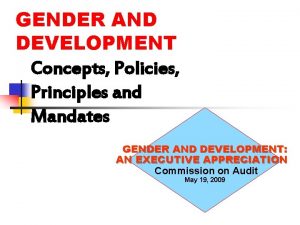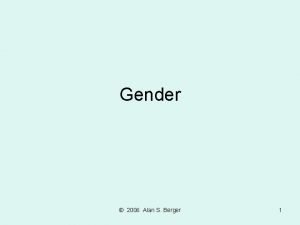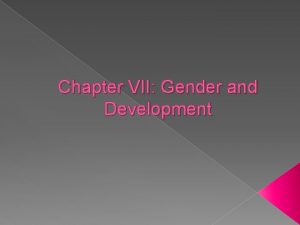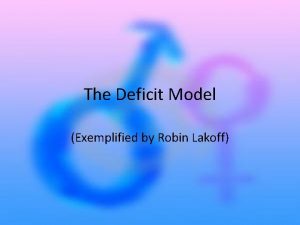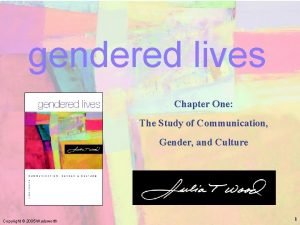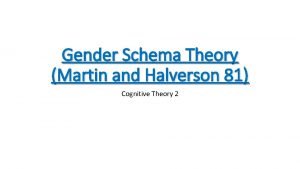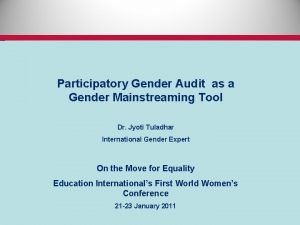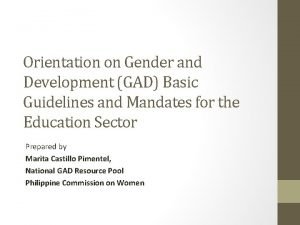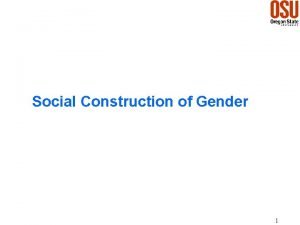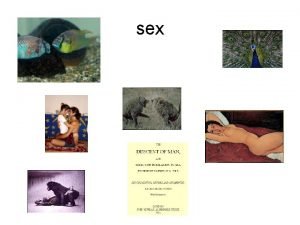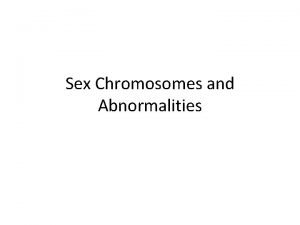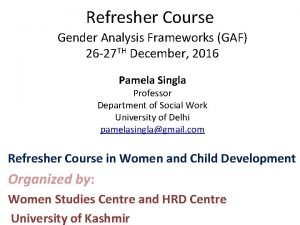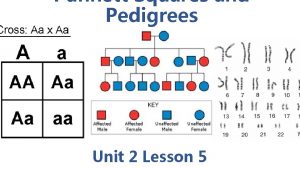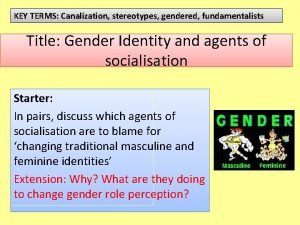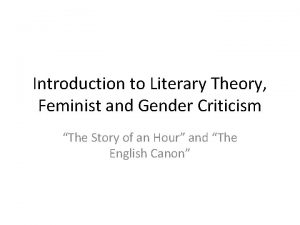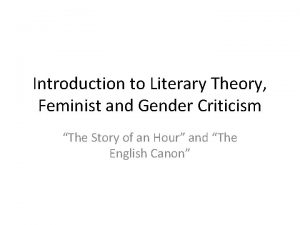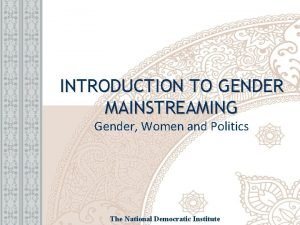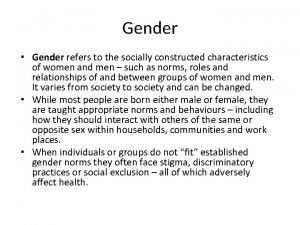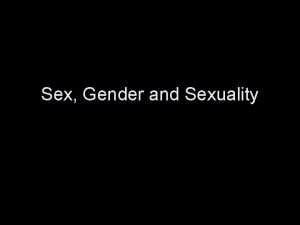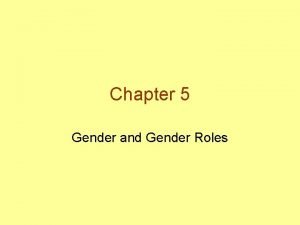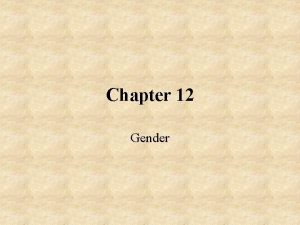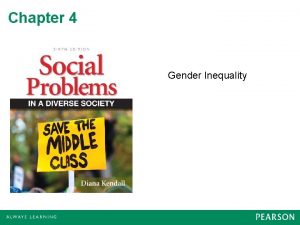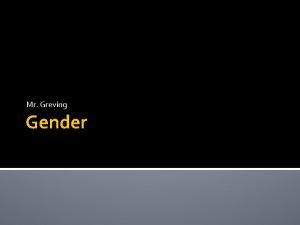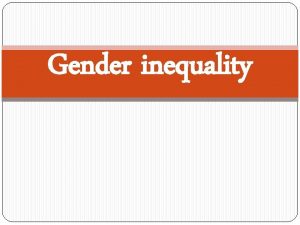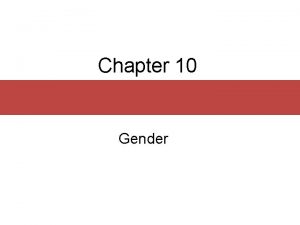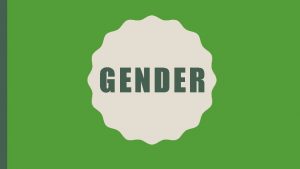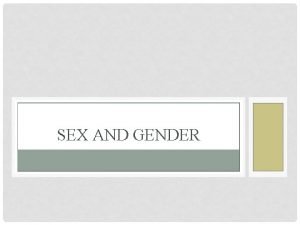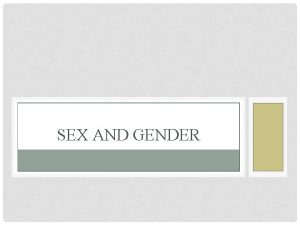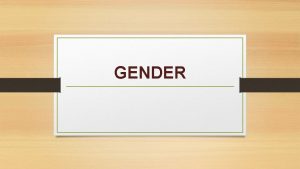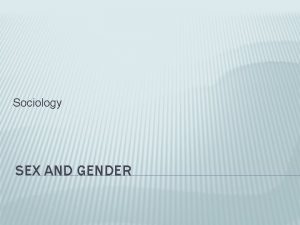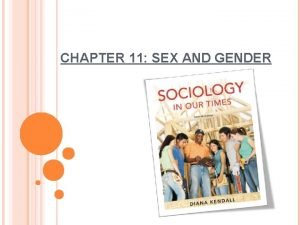Chapter 11 Sex and Gender Chapter Outline Sex




































































- Slides: 68

Chapter 11 Sex and Gender

Chapter Outline § § Sex: The Biological Dimension Gender: The Cultural Dimension Gender Stratification in Historical and Contemporary Perspective Gender and Socialization

Chapter Outline § § § Contemporary Gender Inequality Perspectives on Gender Stratification Gender Issues in the Future

Objectification § § The process of treating people as if they were objects or things, not human beings. We objectify people when we judge them on the basis of their physical appearance rather than on the basis of their individual qualities or actions.

General Aspects Of Objectification Based On Objectification Preoccupation With “Looks” Women are responded to Women are often seen as the primarily as “females, ” objects of sexual attraction, personal accomplishments not full human. are less important. Women are seen by some as Women are seen as “all depersonalized body parts. alike. ” Example: “a piece of ass. ” Depersonalized female Women are seen as sexuality is used for economic passive, so things can purposes. In the media, easily be “done to a advertising, fashion and woman”. (discrimination, cosmetics industries, and harassment, and violence. pornography.

How Much Do You Know About Body Image and Gender? § True or False? § Most people have an accurate perception of their physical appearance.

How Much Do You Know About Body Image and Gender? § False § Many people do not have a very accurate perception of their bodies. § For example, many girls and women think of themselves as “fat” when they are not. § Some boys and men believe that they need a well-developed chest and arm muscles, broad shoulders, and a narrow waist.

How Much Do You Know About Body Image and Gender? § True or False? § Physical attractiveness is a more central part of self-concept for women than for men.

How Much Do You Know About Body Image and Gender? § True. § Women have been socialized to believe that being physically attractive is very important. Studies have found that weight and body shape are the central determinants of women’s perception of their physical attractiveness.

Sex § § Sex refers to the biological differences between females and males. At birth, infants are distinguished by primary sex characteristics: the genitalia used in the reproductive process.

Secondary Sex Characteristics § At puberty, hormones result in development of secondary sex characteristics: § Women: larger breasts, wider hips, and narrower shoulders; a layer of fatty tissue throughout the body; and menstruation. § Men: enlarged genitals, a deeper voice, greater height, a more muscular build, more body and facial hair.

Hermaphrodites § § § Caused by a hormone imbalance, a hermaphrodite has a combination of male and female genitalia. Western societies acknowledge two sexes: Male and Female. Other societies recognize a third as well: § Berdaches - males who behave, dress, work, and are treated as women.

Transsexual § § A person in whom the sex-related structures of the brain that define gender identity are opposite from the physical sex organs of the person’s body. § Transsexuals often feel that they are the opposite sex from that of their sex organs. A transvestite is a male who lives as a woman or a female who lives as a man but does not alter the genitalia.

Sexual Orientation § § § Refers to preference for emotional–sexual relationships with : § The opposite sex - heterosexuality § The same sex - homosexuality § Both sexes - bisexuality Homosexual and gay are most often used with males who prefer same-sex relationships. Lesbian is used in association with females who prefer same-sex relationships.

Question § Homosexual relations should be taught as acceptable and normal. a. Strongly agree b. Agree somewhat c. Unsure d. Disagree somewhat e. Strongly disagree

Identifying Sexuality § In a definitive study of sexuality in the mid 1990 s, researchers at the University of Chicago established three criteria for identifying people as homosexual or bisexual: 1. Sexual attraction to persons of one’s own gender. 2. Sexual involvement with one or more persons of one’s own gender. 3. Self-identification as a gay, lesbian, or bisexual.

Homophobia § Extreme prejudice directed at gays, lesbians, bisexuals, and others who are perceived as not being heterosexual.

Question § What about sexual relations between two adults of the same sex: § Do you think it is always wrong, almost always wrong, wrong only sometimes, or not wrong at all?

GSS National Data Region East Midwest South West Always 51. 5% 65. 3% 73% 53. 5% Almost Always 15. 9% 10. 4% 9. 7% 11. 9% Not Wrong 32. 6% 24. 3% 17. 3% 34. 6%

Gender § § § Gender refers to culturally and socially constructed differences between females and males found in the meanings, beliefs, and practices associated with “femininity” and “masculinity. ” Gender is embedded in the images, ideas, and language of a society. Gender is used as a means to divide up work, allocate resources, and distribute power.

Gender § § § Gender role refers to attitudes, behavior, and activities that are defined as appropriate for each sex and learned through the socialization process. In U. S. society, males are expected to demonstrate aggressiveness whereas females are expected to be passive and nurturing. Gender identity is a person’s perception of the self as female or male.

Question § How comfortable are you with the gender roles our society defines as appropriate for males and females? a. Very comfortable b. Somewhat comfortable c. Unsure d. Somewhat uncomfortable e. Very uncomfortable

Sexism toward Women § Three components: § Negative attitudes toward women. § Stereotypical beliefs that reinforce, complement, or justify the prejudice. § Discrimination - acts that exclude, distance, or keep women separate.

Sexism § § Sexism is interwoven with patriarchy—a hierarchical system of social organization in which cultural, political, and economic structures are controlled by men. Matriarchy is a hierarchical system of social organization in which cultural, political, and economic structures are controlled by women.

Question § Do you agree or disagree: § It is much better for everyone involved if the man is the achiever outside the home and the woman takes care of the home and family.

GSS National Data Age <30 30 -49 50 and up Agree 24. 3% 30. 1% 57. 6% Disagree 75. 7% 69. 9% 42. 4% Education Not a High School College Graduate Educated Agree 58. 5% 42. 1% 29. 6% Disagree 41. 2% 57. 9% 70. 4%

Gender Stereotypes § § Men § strong, rational, dominant, independent, less concerned with appearance Women § weak, emotional, nurturing, dependent, anxious about appearance

Question § Do you approve or disapprove of a married woman earning money in business or industry if she has a husband capable of supporting her? a. Approve b. Disapprove c. No opinion

Gendered Division of Labor Three factors: § Type of subsistence base. § Supply of and demand for labor. § The extent to which women's child-rearing activities are compatible with certain types of work.

Hunting and Gathering Society Economic Characteristics Hunting game, gathering roots and berries Control of Surplus None Inheritance None Control over Procreation None Women’s Status Relative Equality

Horticultural and Pastoral Economic Characteristics Control of Surplus Planting crops, domestication of animals for food Men begin to control societies Inheritance Shared—patrilineal and matrilineal Control over Procreation Increasingly by men Women’s Status Decreasing in move to pastoralism

Agrarian Economic Characteristics Labor-intensive farming Control of Surplus Men who own land or herds Inheritance Patrilineal Control over Procreation Men—to ensure legitimacy of heirs Women’s Status Low

Industrial Economic Characteristics Mechanized production of goods Control of Surplus Men who own means of production Inheritance Bilateral Control over Procreation Men—but less so in later stages Women’s Status Low

Postindustrial Economic Characteristics Information and service economy Control of Surplus Corporate shareholders and hightech entrepreneurs Inheritance Bilateral Control over Procreation Mixed Women’s Status Varies by class, race, and age

Single Mothers with Children Under 18 § § Between 1990 and 2000, the number of U. S. families headed by single mothers increased by about 25%. This marks a change in the roles of many women, and may indicate that “traditional” households are in decline in

Parents and Gender Socialization § § Children's clothing and toys reflect their parents' gender expectations. Children are often assigned household tasks according to gender.

Peers and Gender Socialization § § § Peers help children learn gender-appropriate and inappropriate behavior. During adolescence, peers often are more effective at gender socialization than adults. College student peers play an important role in career choices and the establishment of long term, intimate relationships.

Schools and Gender Socialization § § Teachers provide messages about gender through classroom assignments and informal interactions with students. Teachers may unintentionally show favoritism toward one gender over the other, this is called, gender bias.

Sports and Gender Socialization § From elementary school through high school: Boys play football. § Girls are cheerleaders, members of the drill team, and homecoming queens. § § For many males, sports is a training ground for masculinity.

Mass Media and Gender Socialization On television: § Male characters typically are more aggressive, constructive, and direct. § Females are deferential toward others or use manipulation to get their way.

Question § If you could temporarily be the other gender, how long would you like to do so? a. One day b. One week c. I have no desire to be the other gender

% of Women, African Americans, Hispanics in Selected Occupations Women African American Hispanic Managerial, Professional 50. 0 8. 3 5. 1 Technical, sales, support 63. 7 11. 4 9. 1 Service jobs 60. 4 17. 9 16. 3 Operators, laborers 23. 3 15. 6 17. 7

Pay Equity § § The wage gap is the disparity between women’s and men’s earnings. § Women make 79 cents for every $1 earned by men. § Women receive less pay than men with the same education. Pay equity or comparable worth is the belief that wages should reflect the worth of a job, not the gender or race of the worker.

The Wage Gap

The Wage Gap

The Wage Gap

Views of Division of Labor by Gender Theory View Functionalism Women’s roles as caregivers are crucial in ensuring that societal tasks are fulfilled. Conflict Division of labor within families and the workplace results from male control and dominance over women and resources.

Importance of Traditional Gender Roles § According to Talcott Parsons, women’s roles as caregivers are more pronounced in contemporary industrialized societies. § The husband provides economic support and makes decisions. § The wife provides affection and emotional support for the family. § This division of family labor provides stability for family members.

The Human Capital Model § § According to this model, individuals vary in the amount of human capital they bring to the labor market. Human capital is acquired by education and job training; it is the source of a person’s productivity and can be measured in terms of the return on the investment (wages) and the cost (schooling or training).

Feminism § § § The belief that women and men are equal and should be valued equally and have equal rights. In liberal feminism, gender equality is equated with equality of opportunity. According to radical feminists, male domination causes all forms of human oppression, including racism and classism.

Feminism § § Socialist feminists suggest that women’s oppression results from their dual roles as paid and unpaid workers in a capitalist economy. Multicultural feminists analyze race, class, and gender and suggest that equality will occur only when all women, regardless of race/ethnicity, class, age, religion, sexual orientation, or ability (or disability), are treated more equitably.

Quick Quiz

1. Primary sex characteristics are: a. genitalia. b. ones that are most important in a relationship. c. clothing that a person wears. d. characteristics such as facial hair and tone of voice that are obvious when meeting someone.

Answer: a § Primary sex characteristics are genitalia.

2. A ____ is a person whom the sexrelated structures of the brain that define gender identity are opposite from the physical sex organs of the person's body. a. transsexual b. hermaphrodite c. transvestite d. berdaches

Answer: a § A transsexual is a person whom the sexrelated structures of the brain that define gender identity are opposite from the physical sex organs of the person's body.

3. Extreme prejudice against gays, lesbians, bisexuals, and non-heterosexuals is: a. thesbianophobia b. xenophobia c. homophobia d. agoraphobia

Answer: c § Extreme prejudice against gays, lesbians, bisexuals, and nonheterosexuals is homophobia.

4. Body consciousness is: a. how a person perceives and feels about his or her body b. how a person imagines others feel about his or her body c. recognizing reality outside the individual experience d. recognizing how society shapes our perceptions of what beauty is.

Answer: a § Body consciousness is how a person perceives and feels about his or her body.

5. Pay gap refers to: a. the disparity that exists between earnings of individuals based on age. b. the disparity between classes of people in earned income. c. the disparity that exists in earnings between males and females. d. the disparity that exists between various racial and ethnic group income.

Answer: c § Pay gap refers to the disparity that exists in earnings between males and females.

6. The belief that women’s oppression results from their dual roles as paid and unpaid workers in a capitalist economy is called: a. radical feminism b. liberal feminism c. socialist feminism d. multicultural feminism

Answer: c § The belief that women’s oppression results from their dual roles as paid and unpaid workers in a capitalist economy is called socialist feminism.

7. Gender socialization typically stops once one discontinues attending school. a. False. b. True.

Answer: a § Gender socialization does not typically stop once one discontinues attending school.

8. According to the Conflict theory perspective on gender: a. the division of labor in families and the workplace results from male control of and dominance over women and resources. b. gender relations have evened out enough to make the proclamation that gender inequality is a thing of the past. c. gender equality is agreed upon, but the legislation is not enacted as of yet. d. gender dominance will swing toward women in the late 21 st century due to their increasing numbers in universities.

Answer: a § According to the Conflict theory perspective on gender: the division of labor in families and the workplace results from male control of and dominance over women and resources.
 Kurt bumby
Kurt bumby Snv sex
Snv sex Xxtesticles
Xxtesticles Sex sex sex
Sex sex sex Sex sex sex
Sex sex sex Chapter 10 sex gender and sexuality
Chapter 10 sex gender and sexuality Strategic gender needs and practical gender needs
Strategic gender needs and practical gender needs Difference between sex and gender
Difference between sex and gender Difference between gender and sex
Difference between gender and sex Sex
Sex Gender and sex difference
Gender and sex difference Difference between sex and gender
Difference between sex and gender Sex vs gender essay video
Sex vs gender essay video Sex determination and sex linkage
Sex determination and sex linkage Sex linkage
Sex linkage Sex determination and sex linkage
Sex determination and sex linkage How to write a quote sandwich
How to write a quote sandwich Once a sex offender always a sex offender
Once a sex offender always a sex offender Chapter 11 gender age and health review worksheet answers
Chapter 11 gender age and health review worksheet answers George keith and john shuttleworth
George keith and john shuttleworth Snow white 1812
Snow white 1812 Gender-neutral housing pros and cons
Gender-neutral housing pros and cons Performative acts and gender constitution judith butler
Performative acts and gender constitution judith butler Gender and interpersonal communication
Gender and interpersonal communication Agegender
Agegender Gender and development
Gender and development Gad concepts and principles
Gad concepts and principles Gender social stratification
Gender social stratification Objectives of gender and development
Objectives of gender and development Robin lakoff deficit theory
Robin lakoff deficit theory Schema theory strengths and weaknesses
Schema theory strengths and weaknesses Dynamic approach language and gender
Dynamic approach language and gender Centre for gender diversity and inclusion statistics
Centre for gender diversity and inclusion statistics What is the study of communication, gender and culture
What is the study of communication, gender and culture Sexual orientation ap psychology
Sexual orientation ap psychology Gender issue in school
Gender issue in school Centre for gender diversity and inclusion statistics
Centre for gender diversity and inclusion statistics Martin halverson
Martin halverson Language and gender
Language and gender Gender and development
Gender and development Sample lesson plan in gender and development
Sample lesson plan in gender and development Blood pressure chart by age and gender
Blood pressure chart by age and gender Gender based violence
Gender based violence Gender punnett square
Gender punnett square Xxy gender
Xxy gender Gender action plan world bank
Gender action plan world bank Gender action plan world bank
Gender action plan world bank Wid wad gad differences
Wid wad gad differences Unesco
Unesco The simple truth about the gender pay gap
The simple truth about the gender pay gap Define gender constancy
Define gender constancy Socialization is a life-long process.
Socialization is a life-long process. Definition of gender
Definition of gender Xxy chromosome gender
Xxy chromosome gender Person with xxy chromosomes
Person with xxy chromosomes Caroline moser gender analysis framework
Caroline moser gender analysis framework Is there any bias in gender roles based on the excerpt
Is there any bias in gender roles based on the excerpt Punnett square pedigree
Punnett square pedigree Paradigm shift from women studies to gender studies
Paradigm shift from women studies to gender studies Mbti by gender
Mbti by gender Canalization gender example
Canalization gender example Gender criticism definition
Gender criticism definition Gender criticism definition
Gender criticism definition What is gender mainstreaming?
What is gender mainstreaming? Studievoortgangsbewaking
Studievoortgangsbewaking What is gender responsive pedagogy
What is gender responsive pedagogy What is gender mainstreaming?
What is gender mainstreaming? Stefan vater
Stefan vater Refers to the socially constructed roles
Refers to the socially constructed roles





